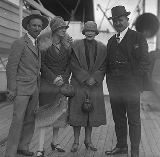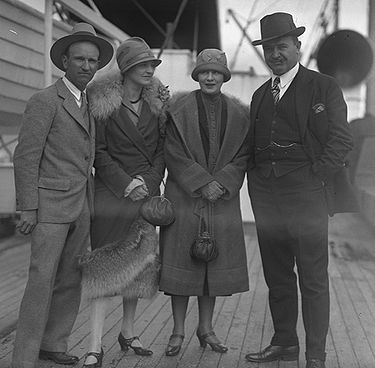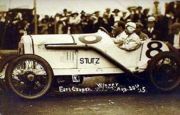
Earl Cooper
Encyclopedia


United States
The United States of America is a federal constitutional republic comprising fifty states and a federal district...
racecar driver.
Racing career
He began his racing career in 1908 in San Francisco in a borrowed car. He won the race, but lost his job as a mechanic after he beat one of his bosses, so he became a full-time racer. He joined the StutzStutz
Stutz may refer to:*Harry C. Stutz , American automobile pioneer and manufacturer of luxury cars and fire engines*Josef Stutz , Swiss Conservative politician*Stutz Motor Company, American luxury cars producer...
team in 1912. In 1913 he won seven of eight major races (and finished second in the other), and won the AAA
American Automobile Association
AAA , formerly known as the American Automobile Association, is a federation of 51 independently operated motor clubs throughout North America. AAA is a not-for-profit member service organization with more than 51 million members. AAA provides services to its members such as travel, automotive,...
national championship. He was injured for the 1914 season. He missed the first several months of the 1915 season, but won the AAA championship anyhow. Cooper got another late start in 1916 after Stutz pulled out of racing, and he finished fifth in the championship. He won his third title in 1917 when the season was shortened by the outbreak of World War I
World War I
World War I , which was predominantly called the World War or the Great War from its occurrence until 1939, and the First World War or World War I thereafter, was a major war centred in Europe that began on 28 July 1914 and lasted until 11 November 1918...
, after which Cooper officially retired from full time racing.
Cooper raced in the 1919 Indianapolis 500
Indianapolis 500
The Indianapolis 500-Mile Race, also known as the Indianapolis 500, the 500 Miles at Indianapolis, the Indy 500 or The 500, is an American automobile race, held annually, typically on the last weekend in May at the Indianapolis Motor Speedway in Speedway, Indiana...
.
Cooper returned to replace Joe Thomas
Joe Thomas (driver)
Joe Thomas was an American racecar driver.-Indy 500 results:...
who broke his arm in October 1921, and won a 200 miles (321.9 km) race at Fresno. He returned to racing full-time in 1922, and won five races in 1923.
Cooper raced in the 1924 Indianapolis 500, and was leading after 400 miles (643.7 km). A tire blew, and he had to pit. He returned second, and worked his way back to the lead with 30 miles (48.3 km) left in the race. He blew another tire just as he was passing Joe Boyer
Joe Boyer
Joe Boyer was a co-winner of the 1924 Indianapolis 500. Boyer was born in Detroit, Michigan.At the 1924 Indianapolis 500, Boyer participated in two different cars during the race. In his original entry , he qualified 4th. On the 109th lap he was relieved. His relief driver went on to race until...
, and the pit stop forced him to settle for second. He started at Indy in 1925, and won the pole in his final Indy 500 in 1926. He retired for good in 1928.
Indy 500 results
|
| |||||||||||||||||||||||||||||||||||||||||||||||||||||||||||||||||||||||||||||||||||||||||||||||

